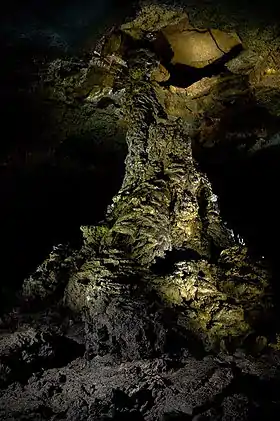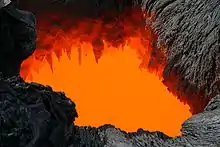Lava tube
A lava tube, or pyroduct,[1] is a natural conduit formed by flowing lava from a volcanic vent that moves beneath the hardened surface of a lava flow. If lava in the tube empties, it will leave a cave.





Formation
A lava tube is a type of lava cave formed when a low-viscosity lava flow develops a continuous and hard crust, which thickens and forms a roof above the still-flowing lava stream. Tubes form in one of two ways: either by the crusting over of lava channels, or from pāhoehoe flows where the lava is moving under the surface.[2]
Lava usually leaves the point of eruption in channels. These channels tend to stay very hot as their surroundings cool. This means they slowly develop walls around them as the surrounding lava cools and/or as the channel melts its way deeper. These channels can get deep enough to crust over, forming an insulating tube that keeps the lava molten and serves as a conduit for the flowing lava. These types of lava tubes tend to be closer to the lava eruption point.
Farther away from the eruption point, lava can flow in an unchanneled, fan-like manner as it leaves its source, which is usually another lava tube leading back to the eruption point. Called pāhoehoe flows, these areas of surface-moving lava cool, forming either a smooth or rough, ropy surface. The lava continues to flow this way until it begins to block its source. At this point, the subsurface lava is still hot enough to break out at a point, and from this point the lava begins as a new "source". Lava flows from the previous source to this breakout point as the surrounding lava of the pāhoehoe flow cools. This forms an underground channel that becomes a lava tube.[3]
Characteristics
A broad lava-flow field often consists of a main lava tube and a series of smaller tubes that supply lava to the front of one or more separate flows. When the supply of lava stops at the end of an eruption or lava is diverted elsewhere, lava in the tube system drains downslope and leaves partially empty caves.
Such drained tubes commonly exhibit step marks on their walls that mark the various depths at which the lava flowed, known as flow ledges or flow lines depending on how prominently they protrude from the walls. Lava tubes generally have pāhoehoe floors, although this may often be covered in breakdown from the ceiling. A variety of speleothems may be found in lava tubes[4] including a variety of stalactite forms generally known as lavacicles, which can be of the splash, "shark tooth", or tubular varieties. Lavacicles are the most common of lava tube speleothems. Drip stalagmites may form under tubular lava stalactites, and the latter may grade into a form known as a tubular lava helictite. A runner is a bead of lava that is extruded from a small opening and then runs down a wall. Lava tubes may also contain mineral deposits that most commonly take the form of crusts or small crystals, and less commonly, as stalactites and stalagmites. Some stalagmites may contain a central conduit and are interpreted as hornitos extruded from the tube floor.[5]
Lava tubes can be up to 14–15 metres (46–49 ft) wide, though are often narrower, and run anywhere from 1–15 metres (3 ft 3 in–49 ft 3 in) below the surface. Lava tubes can also be extremely long; one tube from the Mauna Loa 1859 flow enters the ocean about 50 kilometers (31 mi) from its eruption point, and the Cueva del Viento–Sobrado system on Teide, Tenerife island, is over 18 kilometers (11 mi) long, due to extensive braided maze areas at the upper zones of the system.
A lava tube system in Kiama, Australia, consists of over 20 tubes, many of which are breakouts of a main lava tube. The largest of these lava tubes is 2 meters (6.6 ft) in diameter and has columnar jointing due to the large cooling surface. Other tubes have concentric and radial jointing features. The tubes are infilled due to the low slope angle of emplacement.
Extraterrestrial lava tubes
Lunar lava tubes have been discovered[6] and have been studied as possible human habitats, providing natural shielding from radiation.[7]
Martian lava tubes are associated with innumerable lava flows and lava channels on the flanks of Olympus Mons. Partially collapsed lava tubes are visible as chains of pit craters, and broad lava fans formed by lava emerging from intact, subsurface tubes are also common.[8]
Examples
- Iceland
- Raufarhólshellir
- Surtshellir – For a long time, this was the longest known lava tube in the world.[9]
- Kenya
- Leviathan Cave – At 12.5 kilometres, it is the longest lava tube in Africa.[10]
- Portugal
- Gruta das Torres – Lava tube system of the Azores.
- South Korea
- Manjang Cave – more than 8 kilometers long, located in Jeju Island, is a popular tourism spot.[11]
- Spain
- Cueva de los Verdes – Lava tube system. Lanzarote, Canary Islands.
- United States
- Kazumura Cave, Hawaii – Not only the world's most extensive lava tube, but at 65.5 kilometres (40.7 mi), it has the greatest linear extent of any cave known.[12]
- Lava River Cave in Oregon's Newberry National Volcanic Monument.[13]
See also
- Caving – Recreational pastime of exploring cave systems
- Geology of the Moon – Structure and composition of the Moon
- Lava cave – Cave formed in volcanic rock, especially one formed via volcanic processes
- Mars habitat – A facility where humans could live on Mars
- Speleology – Science of cave and karst systems
- Speleothem – A structure formed in a cave by the deposition of minerals from water
Notes
| Wikimedia Commons has media related to Lava tubes. |
- "Hawaiʻi Volcanoes National Park – Lava Tubes". National Park Service. 28 April 2020. Retrieved 21 July 2020.
- "Lava Tube". United States Geological Survey Photo glossary of volcano terms. 2000. Archived from the original on 2007-07-14. Retrieved 2007-08-07.
- The Virtual Lava Tube Archived 2004-07-26 at the Wayback Machine goodearthgraphics.com, Large educational site on lava tube features and how they form, with many photos, Retrieved 2018-06-19
- Bunnell, D. (2008). Caves of Fire:Inside America's Lava Tubes. National Speleological Society, Huntsville, AL. ISBN 978-1-879961-31-9.
- Polyak, Victor J.; Provencio, Paula P. (2020). "The 'hornito-style' lava stalagmites and lava column in Lava Column Cave, El Malpais National Monument" (PDF). New Mexico Geological Society Special Publication. 14: 37–40. Retrieved 24 October 2020.
- Handwerk, Brian (October 26, 2009), First Moon 'Skylight' Found -- Could House Lunar Base?, National Geographic, archived from the original on 2011-10-10, retrieved 2011-01-27
- "Lunar Lava Tubes Radiation Safety Analysis". Division for Planetary Sciences 2001 meeting. American Astronomical Society. November 2001. Archived from the original on 2002-09-23. Retrieved 2007-08-07.
- Richardson, J.W. et al. (2009). The Relationship Between Lava Fans and Tubes on Olympus Mons in the Tharsis Region, Mars. Archived 2012-10-28 at the Wayback Machine 40th Lunar and Planetary Science Conference, Abstract #1527, Retrieved 2018-06-19
- "Surtshellir-Stefánshellir System". Caves of Iceland. Showcaves. Archived from the original on 2012-04-24. Retrieved 2007-08-07.
- Forti; Galli; Rossi (July 2004). "Minerogenesis of Volcanic Caves of Kenya". International Journal of Speleology. 32: 3–18. doi:10.5038/1827-806X.32.1.1. Archived from the original on 2017-04-09. Retrieved 7 Apr 2017.
- Barclay, Jennifer (2012-04-27). "10 Reasons Travelers Can't Keep Away from Jeju Island". CNN Travel. Archived from the original on 2015-12-24. Retrieved 2015-12-23.
- Gulden, Bob (2011-06-21), World's Longest Lava Tubes, retrieved 2011-06-26
- Newberry National Volcanic Monument